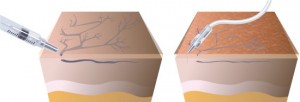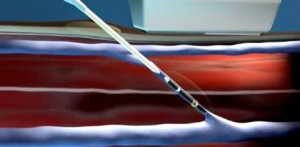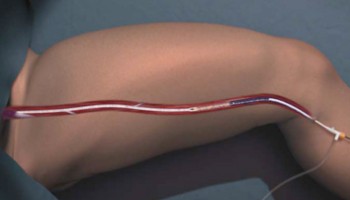TREATMENTS
Radiofrequency ablation is a minimally invasive procedure to treat the underlying cause of varicose veins.
Once a vein wall becomes diseased, the vein becomes stretched and enlarged. The valves within the walls that control the flow of blood through the vein become damaged as the wall becomes more and more stretched. The only alternative is to re-route blood flow through healthy veins by closing the veins, painlessly and easily, using radiofrequency energy.
How is a Radiofrequency Ablation procedure performed?
Once the diseased vein is closed, blood is rerouted to other healthy veins. Following the procedure, a simple bandage is placed over the insertion site, and additional compression is applied. Your vein specialist will encourage you to walk at frequent intervals and to refrain from prolonged standing and strenuous activities for a period of time.
What Can I Expect After a Radiofrequency Ablation Procedure?
The majority of patients experience instant relief from the aching, heaviness, tiredness and pain associated with vein disease. The recovery period is minimal with most people resuming normal activities right away or within a day or two. There may be a minuscule scar left at the insertion point.
Sclerotherapy is a cosmetic, minimally invasive medical procedure used to treat surface varicose veins and spider veins.
How is Sclerotherapy Performed?
 A tiny needle is used to inject an irritant solution directly into the vein. The solution irritates the lining of the vessel, causing it to swell and stick together, and the blood to clot. Overtime, the body will absorb the treated vein. Mild discomfort may occur, and a cramping sensation may be felt for 1 to 2 minutes when larger veins are injected.
A tiny needle is used to inject an irritant solution directly into the vein. The solution irritates the lining of the vessel, causing it to swell and stick together, and the blood to clot. Overtime, the body will absorb the treated vein. Mild discomfort may occur, and a cramping sensation may be felt for 1 to 2 minutes when larger veins are injected.
The number of veins injected in one session is variable, depending on the size and location of the veins, and the patient’s overall medical condition. Anywhere from one to several sclerotherapy sessions may be needed for any vein region.
What Can I Expect After Sclerotherapy?
Medically prescribed support hose and/or bandages may need to be worn for several days to several weeks to assist in resolution of the veins. In general, spider veins respond to treatment in 3 to 6 weeks, and larger veins respond in 3 to 4 months.
Ambulatory phlebectomy is a minimally invasive procedure that surgically removes certain surface veins.
These include veins that remain after the closure of deeper veins as well as bulging veins that are unrelated to any venous reflux disorder.
How is Ambulatory Phlebectomy Performed?
Ambulatory phlebectomy removes “special case” surface veins that, most commonly, remain after a VNUS Closure procedure has been performed to close deeper veins. This is especially the case in people who have had bulging veins over a long period.
Ambulatory Phlebectomy is also performed in conjunction with sclerotherapy and in cases where there are bulging veins but no major indications of venous reflux being present and the deeper saphenous veins are functioning properly.
Even though the vein is surgically removed, it’s very important not to confuse it with vein stripping — where the entire vein is pulled out through one major incision. Ambulatory phlebectomy is a minimally invasive procedure that removes the vein through tiny, imperceptible incisions made along the vein path. The vein is then “fished out,” using a specialized phlebectomy hook.
What Can I Expect After Ambulatory Phlebectomy?
Patients love the look and feel of their brand new legs following the ambulatory phlebectomy procedure. You may experience slight bruising or swelling. A bandage and/or compression stockings are worn post-procedure to aid recovery.
How is ClosureRFS Performed?
 The goal of this procedure is to target the perforator veins, which are those veins that connect the deep saphenous veins with the surface veins. The ClosureRFS Stylet is the only FDA-approved endovenous device for the treatment of diseased, incompetent perforator veins. Through a small opening in the skin, the ClosureFast™ Endovenous Radiofrequency Ablation (RFA) catheter is positioned into the diseased vein, using ultrasound image-guidance. Once the catheter is in, the vein is numbed completely before radiofrequency (RF) energy is delivered through the catheter via the ClosureRFS stylet. The heat causes the vein walls to grow together and eventually become scar tissue, which will then be reabsorbed by the body.
The goal of this procedure is to target the perforator veins, which are those veins that connect the deep saphenous veins with the surface veins. The ClosureRFS Stylet is the only FDA-approved endovenous device for the treatment of diseased, incompetent perforator veins. Through a small opening in the skin, the ClosureFast™ Endovenous Radiofrequency Ablation (RFA) catheter is positioned into the diseased vein, using ultrasound image-guidance. Once the catheter is in, the vein is numbed completely before radiofrequency (RF) energy is delivered through the catheter via the ClosureRFS stylet. The heat causes the vein walls to grow together and eventually become scar tissue, which will then be reabsorbed by the body.
What Can I Expect After ClosureRFS?
Once the diseased vein is closed, blood is rerouted to other healthy veins. Following the procedure, a simple bandage is placed over the insertion site, and additional compression is applied. You will be encouraged to walk at frequent intervals and to refrain from prolonged standing and strenuous activities for a period of time.

